You have probably heard that:
- Leopard geckos are “nocturnal.”
- Leopard geckos are not demanding when it comes to lighting.
You may have even heard that because of their metabolism leos do not require any lights at all.
However, did you know that:
- To stay healthy and happy leos need a particular pattern of light and dark hours which mimic their natural habitat.
- Leos will use the lighting in their tank as an additional heat source.
Let’s shed some light on the leopard gecko’s actual lighting needs.
Do leopard geckos need light?
There is one major misconception about leopard geckos and their need for lighting – or the lack of it.
You will often hear that leopard geckos are nocturnal animals – active mostly at night. That often leads to an automatic conclusion that leos do not require any type of lighting in their tanks.
The conclusion is, unfortunately, not quite right.
First of all, there is no day without night and vice versa. Leos are aware of their surroundings even if they’re snoozing through the day. They know how to tell day from night, and they depend on it for their survival.
Secondly, leos are not nocturnal all the way – they are a crepuscular species, which means they are mostly active at dusk or at dawn. Their activity often extends into the night, true, but it is not when it begins.
Their sensitivity to the time of day means that to maintain a healthy internal clock, leopard geckos require a balanced day (light) and night (darkness) intervals.
> Read More : How to Set Up the Ideal Leopard Gecko Enclosure?
Best Leopard Gecko Lighting Setups
Here is a quick overview of a 5-element setup for any leo tank:
- Incandescent heat lamp as daylight.
- Ceramic bulb for nighttime heating, or a heating pad if your tank is too small.
- Red, blue, or black night light, which should be for a couple of hours while you want to watch your geckos (optional).
- A thermostat and a timer to optimally control your setup.
Or, you can go for a 4-element setup:
- Full spectrum UVA day light.
- Ceramic bulb for 24-hours heating (or a heat pad).
- Red, blue or black night light for a couple of hours of watching (optional).
- A thermostat and a timer to optimally control your setup.
How Much Light Do Leopard Geckos Need Per Day?
When lighting your leo tank, you will try to mimic the Middle Eastern day-night patterns. What this basically means is:
Summer: 14 hours of daytime and 10 hours of nighttime
Winter: 12 hours of daytime, and 12 hours of nighttime.
It is ideal to ensure the transition period between the seasons – gradually decrease (or increase) the intervals for 15-30 minutes per week for 4-8 weeks.
I wholeheartedly recommend you to use an automatic timer to control your lights. Unless you have rigorous personal daily routines, it is easy to forget to turn the lights on and off – and a burden to think about it all the time.
For a regular leo owner, you won’t need anything more complicated than a simple, affordable controller with no advanced options. However, due to safety, I recommend that you get the one from a reputable producer. Zoo Med’s Repti Terrarium Timer meets all those requirements.
See Zoo Med’s Timer on AmazonCan I Use Natural Window Light For My Leos?
Before even considering the possibility of using natural light in your tank, a word of caution: the greatest danger of using window light source is overheating. Unlike with bulbs, you can’t control the intensity of the sun’s rays. If the sun hits your window and the terrarium behind it directly, you may risk overheating your tank.
If the sun doesn’t hit your window directly or does so only for a short period, there should be no danger of overheating. However, I still don’t recommend this method, because it is unlikely that natural daylight cycles where you live will match those which leopard geckos are adjusted to. This is especially important if you are trying to breed leos.
Only in the case your yearly daylight patterns closely match those from leo’s natural habitat described above – then yes, leos will “use” the natural light, and their internal clock should be fine.
To find out if leopard geckos really need a UV source, please read on.
What Is The Best Type Of Light For Leopard Geckos?
When we talk about lights for leopard geckos (and other reptiles), we could divide the bulbs into four main categories:
- Daytime bulbs
- Nighttime bulbs
- Ceramic (heat) bulbs
All of these types of light have their own purpose:
- Daylight lamps simulate daylight and provide heat,
- Nighttime bulbs help you to view your pets and night and also provide heat, albeit less than the daytime heat bulbs,
- Ceramic bulbs provide heat only l(but a lot of it).
Since most lamps emit heat, when choosing the right one, you should also consider the way a particular bulb will affect the temperature in your tank. Lights can be used as a primary or an additional heat source, and/or can help you to create a temperature gradient within the tank. However, be mindful that different types of bulbs produce different amounts of heat. For example, mercury-vapor bulbs can get too hot for small tanks typically used for leopard geckos.
The Right Daytime Lighting For Leopard Geckos
As crepuscular/nocturnal lizard that rarely basks under the light source, the leopard gecko is not overly sensitive to the properties of artificial light in the tank. In the earlier days, the standard opinion was that since leopard geckos are “nocturnal,” they do not need any amount of UV light. The tank light was primarily considered a leopard gecko heat lamp, so merely providing them with a daytime heat lamp for the right amount of hours per day was considered to be enough.
However, in recent years, this practice has been up for debate.
Do Leopard Geckos Need UVB?
The relationship between UVB, Vitamin D3 and the activity patterns of various reptile species is a complex subject, which scientists don’t fully understand.
Generally speaking, most experienced keepers have maintained diurnal species — who presumably require UVB radiation to produce sufficient Vitamin D3 — by providing them with UVB lights. Conversely, nocturnal species, who do not enjoy much exposure to UVB rays, are rarely provided with true full-spectrum lighting, as they’re thought to be able to obtain all of their Vitamin D3 through dietary means.
This means that — historically — leopard gecko keepers and breeders have satisfied their lizards’ D3 needs via a well-rounded diet and supplements.
However, it is important to note a few things:
- There are exceptions and outliers to the assumption that diurnal reptiles require UVB light. For example, very few (if any) snakes are thought to require UVB lighting, including strictly diurnal species.
- A very small number of leopard geckos display symptoms of metabolic bone disease. In some cases, this appears to have occurred even when the lizards were given supplements. However, because these reports are anecdotal, the specifics of these situations are not well documented, which leaves more questions than answers.
- Leopard geckos are probably better described as crepuscular — active at dawn and dusk — rather than nocturnal. So, they likely receive some UVB exposure in the wild.
Given these factors, some keepers have decided to start experimentally providing UVB lights for their leos.
Only time will tell if this approach is safe and beneficial. We don’t even know if leopard geckos can perceive UVB rays like some other reptiles can, nor do we know yet whether or not these lights are harmful to them.
Additionally, it is important to remember that tens of thousands (and potentially hundreds of thousands) of leopard geckos have lived long, healthy lives without UVB lights. Indeed, few large-scale leopard gecko breeders (if any) employ UVB lights with their lizards.
Accordingly, hobbyists are encouraged to approach the UVB issue carefully. It seems highly unlikely that they require UVB lighting, and we know that the vast majority of leopard geckos will remain healthy if provided with a proper diet and supplementation schedule. Just be sure to discuss the issue with your veterinarian if you’re inclined to experiment with UVB lights.
Incandescent Daylight Bulbs for Leopard Geckos
The standard incandescent – tungsten or halogen – bulbs and lamps will do just fine as a primary light and heat source. They emit mostly yellows and reds with no blue part of the spectrum.
The regular home incandescents of proper wattage will do just fine. However, there are also specialized incandescent bulbs for reptiles which are a bit more refined. For example, this Zilla Reptile Day White Terrarium Incandescent Heat Lamp simulates natural daylight by using neodymium glass, which produces brighter, whiter light. It emits light at wavelengths from 400nm to 700nm for visual (visible) light and UVA rays from 315nm to 400nm.
See Zilla Heat Lamp on AmazonFull Spectrum Daylight Bulbs for Leopard Geckos
The term “full spectrum” is used in many ways by reptile keepers, but it usually refers to lights that produce UVA and UVB wavelengths.
As mentioned before, it isn’t clear whether or not UVB-producing bulbs are safe or helpful for leopard geckos. So, it is probably wise to avoid using these types of UVB-producing bulbs unless you are working in conjunction with your veterinarian and using them carefully.
However, if by “full spectrum” lights, you simply mean lights with a well-balanced color spectrum, which will help your leopard gecko and his habitat look their best, there is no reason you can’t do so.
If you want to use a bulb that produces no UVB, just go with something simple, like these Daylight Fluorescent Bulbs. On the other hand, if you do want to try UVB lights with your pet, be sure to stick to ones that produce relatively little UVB, such as these Zoo Med Compact Fluorescent Bulbs.
Leopard Gecko Lighting At Night
Unlike the daytime bulbs, night lighting for leopard geckos isn’t there to simulate daylight – but to enable you to watch your geckos in the evening or at night, when they are the most active. It is like fake moonlight, but with another additional feature. Unlike the moonlight, night lights will also provide some heat.
You’ll be able to find three main types of night lights on the market:
- Red lights
- Blue lights
- “Black” lights
All of the types do pretty much the same thing – heat the terrarium while adding some discrete light in the part of the spectrum that reptiles are thought not to see.
However, this is another topic of hot debate.
An ideal night light will give off just enough light for you to watch your geckos but will be low enough not to disturb your sleep or pet’s activities. Still, it turned out that the assumption that nocturnal reptiles can’t see the red lights is not entirely accurate. Even if they can’t see red, they can still see the light itself – like colorblind people.
I had used a red light in my tank for a few years. In all that time, I had never noticed that my leos were disturbed by the red bulb. Their pupils were dilated as if it was dark, and they would go about their business normally. While I haven’t experimentally compared the activity level with and without the light, I don’t use any type of night light anymore out of precaution nevertheless.
This doesn’t mean you shouldn’t use these bulbs at all, although they are absolutely not necessary. I would advise that you keep them on just as long as you want to watch your leos, and not the entire (night)time.
Leopard Gecko Red Nighttime Bulbs
Red bulbs are commonly used as night lights + heaters in tanks, many of them running for 24 hours each day. They are almost always marketed as “infrared,” though this is not entirely true – the heat that the bulbs emit does belong to the infrared part of the spectrum. However, the visible red light is just that – part of the visible light spectrum.
A quality bulb, like the Zoo Med Nocturnal Infrared Incandescent Heat Lamp (75 Watts) is not merely coated with red paint, but it is made out of genuine red glass. Zoo Med also claims that this bulb emits only a small part of visible light and that it will not interfere with your pet’s day-night cycle.
Leopard Gecko Blue Night Lights
Blue night lights, like this Exo Terra 100 Watt Night Heat Lamp, simulate moonlight by giving off a bluish glow. This will give your tank a more natural look, though some people still prefer the warm glow of infrared lights. When it comes to how potentially disruptive they are, there is no known difference between blue and red lights.
Also, the blue lamps don’t emit a lot of heat and won’t interfere with maintaining the natural nocturnal temperature drop.
Leopard Gecko “Black” Night Lights
Due to concerns about disturbing nocturnal pets, some producers have developed the so-called “black lamps,” such as this Zilla Night Black Heat.
See Zilla Night Back Heat on AmazonThe black light bulbs are claimed to emit very little visual light, giving off only a discrete purplish glow while providing heat. However, their exact effect on leopard gecko’s vision and still unknown, and it is unclear if they are really superior to its black and red counterparts. Black lights are used in the same manner as red and blue lights.
Day/Night Light Combos
Some manufacturers offer combos of day and night bulbs at affordable prices, as well as the fixtures to house them in.
See Zoo Med Light Combo on AmazonIt the case you find quality goods, this can be practical both in the sense of purchase, and the time and space required to install the fixture.
Durability of Light Bulbs
The reviews on the durability of various incandescent bulbs vary greatly. While most manufacturers guarantee a particular lifetime, customers often report that even bulbs from reputable brands burn out much quicker than that. Others, however, report no issues of such kind.
That can be at least partially explained by the fact that the light bulbs are sensitive objects which can be damaged by bad handling. Mishaps can happen both with pet stores and online ordering. So besides informed decision, buying a long-lasting bulb is also a matter of luck.
Always follow the manufacturer’s instructions on how to properly use and house the bulbs. Some are sensitive to overheating, which can happen if they are closed in domes.
Ceramic Heat Bulbs For Leopard Geckos
Despite the marketing, red and blue lights will inevitably emit some percentage of light that is visible to your pet reptile. If you notice a change in behavioral patterns in your leos after adding the nocturnal light, or if you are just cautious like me, then a ceramic bulb – also called a ceramic heat emitter (CHE) – could be a good solution.
Ceramic bulbs are not true light bulbs – because they emit no light, but only heat. However, “heat” actually belongs to the infrared part of the spectrum, making ceramic heat bulbs the real infrared bulbs. And, they provide natural heat, because it comes from above, like the heat of the sun, or the hot rocks above leo burrows. Another upside of CHEs is that they last much longer than any light bulb.
It is better to use CHEs with porcelain sockets, because the plastic ones may melt due to high heat. Also, never touch the heated bulb!
Be careful if you have a small tank – most CHEs emit too much heat for tanks of 20 gallons and under. You should definitely have a thermostat, but you can additionally control the heat output by getting a dimmer switch, or by raising the bulb well above the tank.
ZooMed’s ReptiCare Infrared Ceramic Heat Emitter uses a standard (ceramic) incandescent socket and promises a long lifetime – as long as 5 years.
See Zoo Med Heat Emitter on AmazonSince CHEs are powerful, you will want them to be thermostatically controlled (and I recommend the same for all other heat sources). ReptiTemp RT 600 Digital Thermostat Controller lets you control up to 600 watts of heating devices, and controls temperatures in the range from 50 degrees F to 122 degrees F (10-50 degrees C). Also, it has a built-in alarm which will warn you of extreme temperatures.
See ReptiTemp Thermostat Controller on AmazonLeopard Gecko Lighting Tips
Here are a few general rules you should know when setting up a light in a leopard gecko tank, which can also be applied to all other lizards.
- The light should always be placed directly above your tank, and not come from the sides. See those ridges above your leo’s eyes, the “eyebrows”? They exist to shade their sensitive surface of the eye, but obviously, don’t work if you put the light on the side of the tank.
- Ideally, the light should be placed above and not inside the tank. Lamps that rest on the mesh lid are also fine.
- Do not get the bulb that is too powerful for the size of your tank.
- Set the lights at a proper distance. No light should be closer than six inches from your pet. This gets more complicated in the case your leo can climb all the way to the lid (e.g., stone or 3D background); in that case, the lamp should definitely be hanging over the tank.
- Always check the temperature below the heat lamp.
- Always use guards if your gecko can get near the heat bulb.
- Always follow the manufacturer’s instructions on how to use that bulb.
- Provide hides and caves both on the light side and the darker side of your tank.
It’s Your Turn
I hope I have managed to light up this often neglected, but an important leopard gecko housing topic. Although leos are not as sensitive to the quality of light as some diurnal lizard, the presence and type of lighting has the power to enhance your leo’s life substantially. That is why the right lamps, bulbs, and fixtures are worth the time and the money you will invest in them.

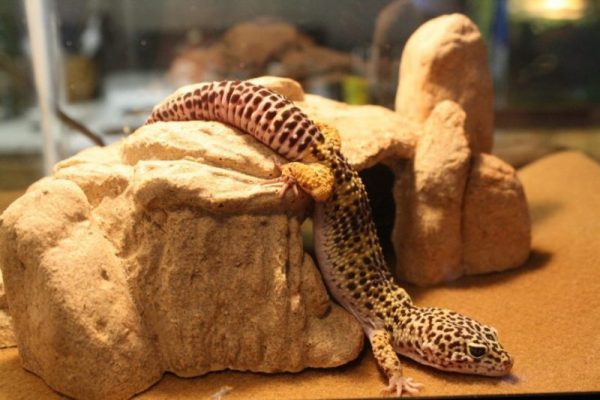
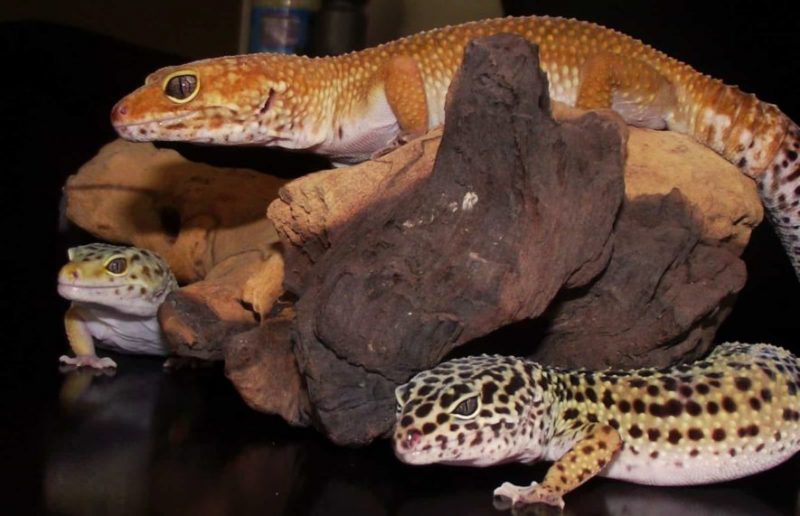
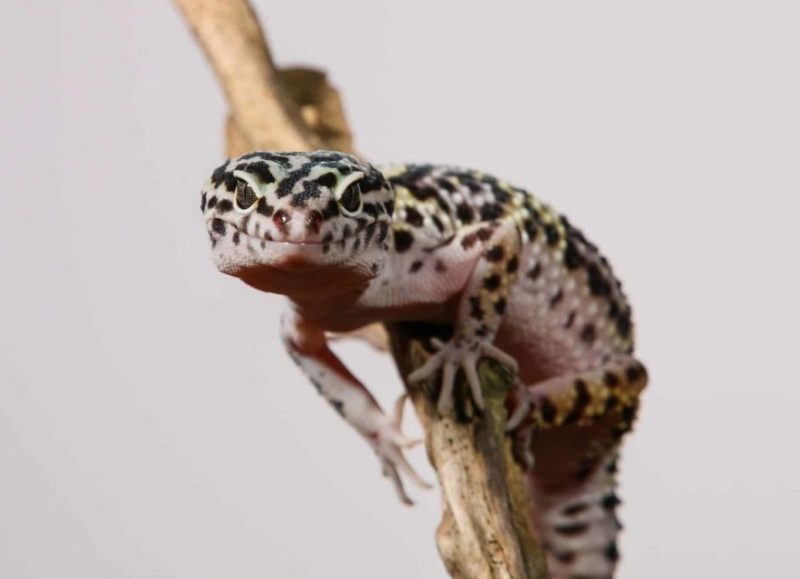
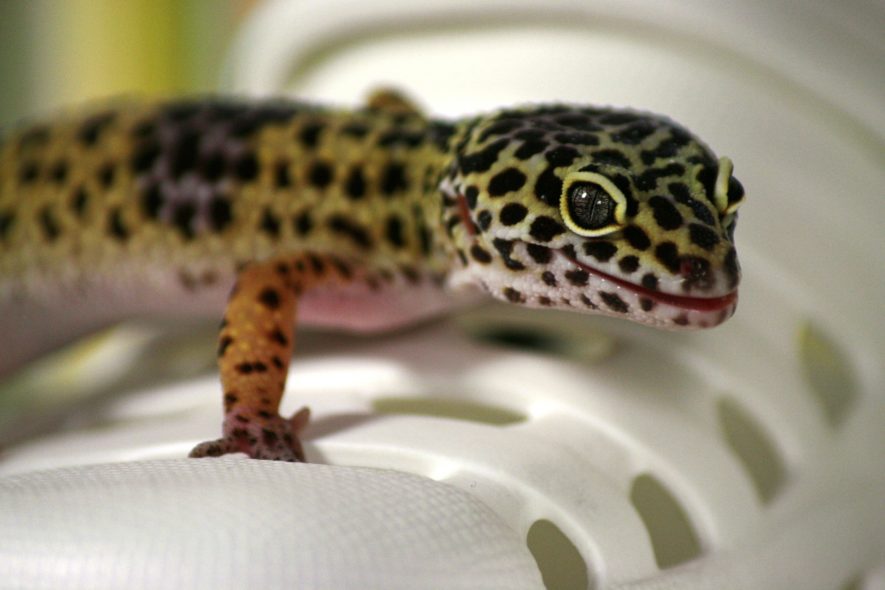
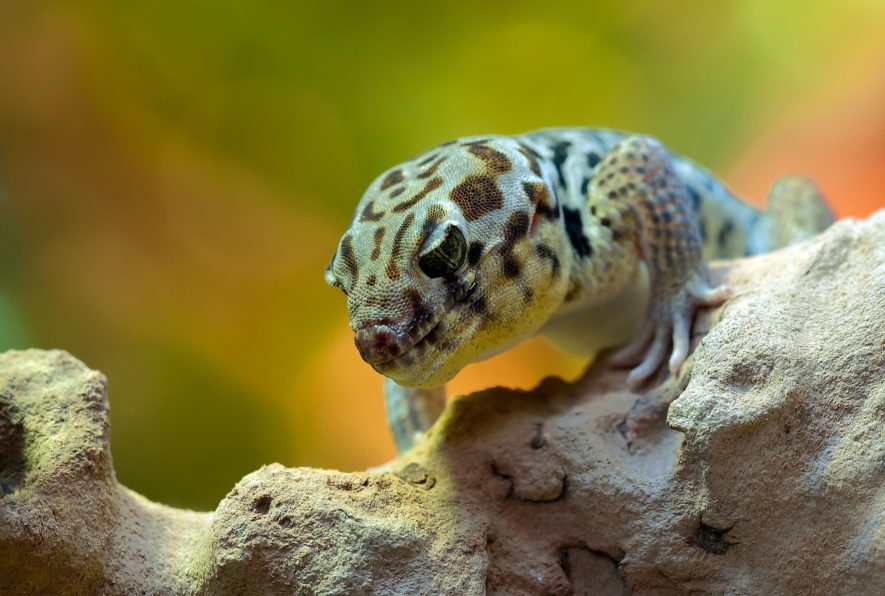
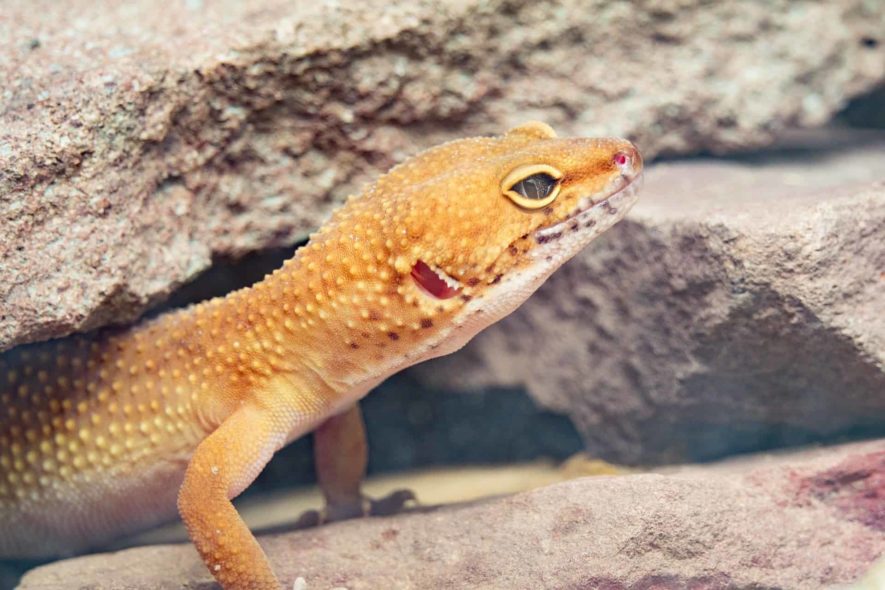
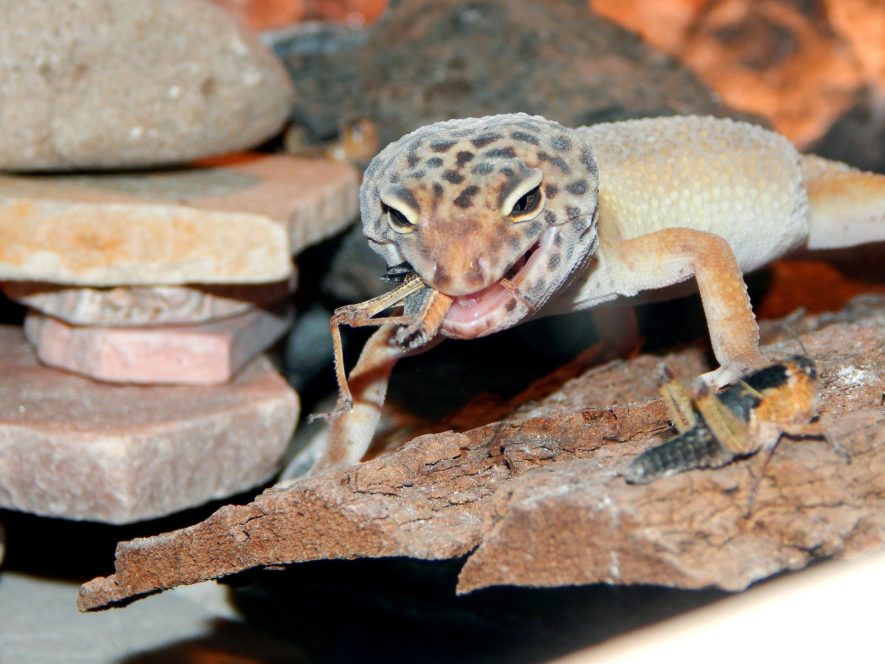
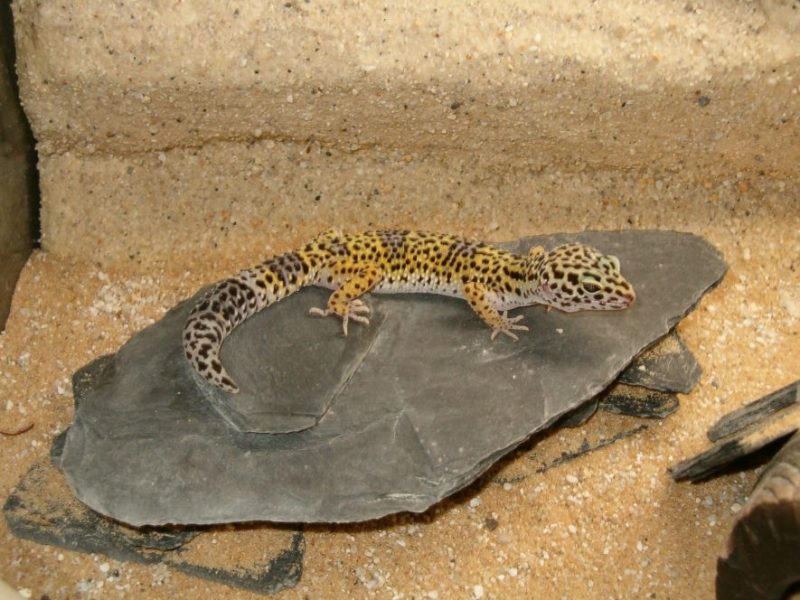
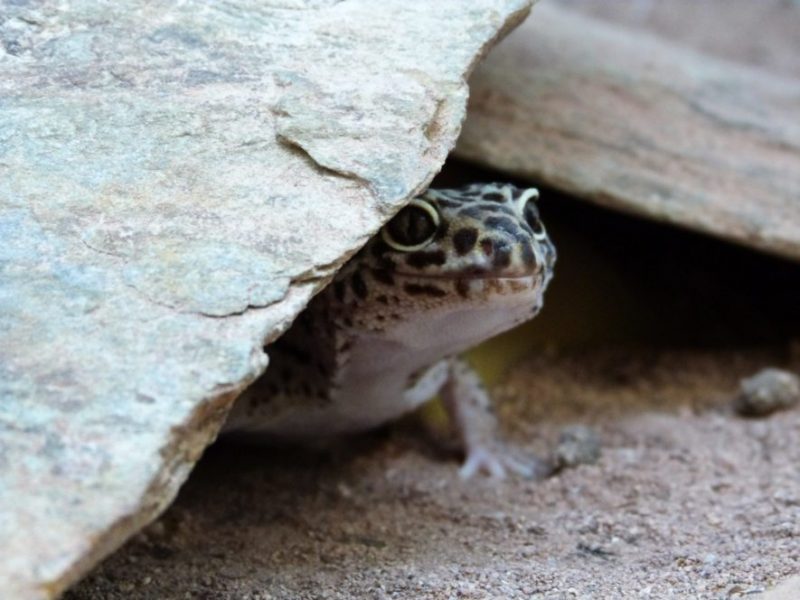

55 Comments
thank you for the article
I have had a bearded dragon for years and he is very easy to take care of. I bought a leopard gecko and now I feel like I am over my head. I want to make sure I understand, I do not need a UVB light for Dobby, just heat lamps. Do I need to keep lamps on all night as well or just a heating element? Also, for the moist hide, do I have the heating light over that or is the heat lamp kept on the opposite side of the tank?
Don’t worry – in my opinion, leopard geckos are even easier to keep than bearded dragons. To answer your questions:
1) Recently, more and more hobbyists include UVB light in their leopard gecko setups, but it is optional. Decades of experience tell us that leos will do just fine if supplemented by Vitamin D3 through their diets. The UVB bulb might be a more natural way to synthesize it, but it is not obligatory, as in the case of bearded dragons
2) Whether or not you keep the heating on at night depends on your room temperatures. Leopard geckos do need cooler nights in comparison with their daytime temps. If the room temperature is not going below 68 Fahrenheit (around 20 degrees C), feel free to turn off all the heating at night. Also, leos like their darkness, so turn off the lamps at night (which also goes other all reptiles).
3) I wouldn’t put the moist hide right under the heating light, but ideally, you should have one moist hide in the warm part of the tank and another one in the cool part of the tank. If your tank space allows only one moist hide, go for somewhere in between, the middle of the tank’s temperature gradient. Hope this helps!
Hello,
We just upgraded to a 40 gallon tank for our leopard gecko. The only heat source is a 75w spot lamp. The lamp is on all day but off at night. There is no other heat source in the tank. What is the best option (not wanting to use a heat pad) for this size tank?
Thank you in advance,
Jason
Hi Jason,
First, upgrading to a 40-gallon tank is awesome and will surely give your lucky gecko a great quality of life. Despite the fact they often hide away and snooze, leos also love to move around quite a bit when given a chance, so congratulations on your decision!
You didn’t say what temperatures you get in your tank with the existing lamp. Just a quick reminder: the optimal daytime temperature is 75 to 85°F during the daytime, with the basking area up to 90°F. Having a heating device on one side of the tank will allow you to create the needed temperature gradient, but ideally, for larger tanks, you should have two thermometers to check temperatures on both sides. As for the night, you can let the nighttime temperatures drop into the low 70s (~20°C is an ideal minimum). How you approach the issue depends on your room temperature at night. For example, I don’t use nighttime heating as my room temperature is never allowed to drop below 68°F. Various sources cite that night temperatures can even go into 60s, but I wouldn’t go lower than 68°F to avoid digestion issues.
Heating pads (aka heat mats) have caught a bad rap recently since some of them seem prone to malfunctioning and burning (eek!). However, getting a quality heading pad and controlling the temperature by connecting it to a thermostat is still quite a safe bet. Some leo owners like heat pads because they provide the heat from below, in theory aiding digestion by heating the lizard’s belly.
For practical reasons, my personal preference has always been a heating source that radiates from above. Such an alternative to a heat mat is the Ceramic Heat Emitter (CHE) or simply – the ceramic bulb. It is installed as a regular bulb but emits heat only. For a 40-gallon tank, the optimal wattage for keeping the nighttime temps in the desirable range is likely 60W, but you could go for 100W if it’s really cold in your room or you intend to use it for daytime. I’d test both options before making the final decision. Keep in mind that the lower nighttime temperatures are actually beneficial for leopard geckos as they can go into a deep sleep and rest better.
In any case, install a reliable thermometer in your tank and check it often – especially while still testing the new setup. Also, you can use a temp gun if you’re worried about a particular spot in the tank getting too hot. I hope this helps!
Both of my daughter’s have geckos that are about a year old now. Each are in their own 20 gallon tank. We have a regular daytime light on during the day for light & heat, and then a ceramic 60 watt at night for heat. What are the daytime & nighttime temps that the tank should be kept at? And do they change at all from summer to winter?
Hi Heather,
The optimum temperature for leopard geckos is 75 to 85°F (~24 to 29°C) during the day, with the basking area going as high as 90°F (~32°C). There should be a temperature gradient between the hot and cool sides of your tank so that the gecko can regulate its body temperature. The nighttime temperature should ideally be in the 70s (~21°C).
Hi there, thanks for all the info. I’m having a very hard time finding a thermostat that has a timer to switch between 2 heat sources, a day lamp for 14 hours and a ceramic heat emitter or heat mat 10 hours but still keeps the terrarium at a constant temp. Please help.
Hi Sarah,
See if you can find an Exo Terra Dual Day/Night Thermostat online.
If the Gecko terrarium is next to a large window do they really even need a daytime lamp? I was considering just getting an Arcadia (or other brand) deep heat projector lamp, do you have any opinion on that?
Hi Arya,
Having your geckos vivarium close to a large window could be detrimental to your leo’s health. If the sun shines into the tank you will not be able to control the temperature of the enclosure and your gecko may not be able to regulate its body temperature properly. When it comes to lighting, I would still suggest providing a low level UV light as UV does not travel through glass (most of it is reflected). In summary, I would relocate the enclosure away from direct light from the window and still provide a proper lighting setup.
Do you leave the heating pad on at all times? Thank you!
Hi Grace,
Yes, make sure your heat mat is connected to a thermostat to regulate the temperature and leave it running 24/7. Leopard Geckos are most active at night and require warmth for movement and digestion.
Hey so I’m thinking about getting a lepard gecko but don’t want the paying for an expensive cost of a heat lamp. Is there another option?
Hey Makayla,
To reduce your energy expenses, try using a basking bulb instead of a heat lamp. Basking bulbs give off less light and heat, making them more power-saving
Hope this helps!
Hi I purchased a leopard gecko in March. Last time Leo owner. Her tank warm side stays anywhere from 87 to 90 . Cool side 72-77. I have a heating pad under her 25 gallon tank. I am currently using a ceramic heater. Whenever I handle my gecko her body feels cold. Does this mean she is cold? I am afraid to turn the pad off because of her cold body. I was encouraged to buy the infrared bulb and then read not to use it in conjunction with the ceramic heater. What would you suggest for the cold body, heating pad and lighting with a ceramic heater? Thank you.
Hi Nancy,
You could increase the cool side of her vivarium to be 75 – 80, the warm side is a good temperature. I would suggest using a heat mat in combination with a ceramic heater or infrared bulb. Your heat mat should be attached to a thermostat and left on 24/7. Leopard Geckos are nocturnal and need the warmth at night to move around and for digestion.
Hi! We just got/rescued our first leopard gecko. We have never had reptiles before. The girl gave us a 10 gallon tank and a dual light dome (with black light & 50 watt day light bulbs) for her. We just recently upgraded to a 40 gallon low tank (36″L x 18″W X 14″H). We put thermometer/humidity gauges on both the cool & hot ends of the tank. The cool end seems to stay around 70 degrees and the hot side only gets to about 80 degrees. We also use an under tank heat mat. I am ordering a thermostat to regulate the mats temperature (wasn’t given one when we got her). Should we switch to a Ceramic Infrared Heat bulb to increase the temp or a higher watt day light bulb? There is plenty of natural light in the room & tank is not in direct sun light. Should we only use the under tank heat mat at night? She is very light colored and don’t want to burn her with a brighter bulb.
Hi Bobbie,
The tank sounds great, although make sure there are plenty of hiding places in there for your gecko as it is quite large. Sounds like you’ve got a great idea of the husbandry needs for your new gecko, although I agree your temperatures are slightly low. Try using a slightly more powerful bulb to get the temps up, as long as your gecko can get away from the direct light it should be fine. When it comes to your heat mat, once it is connected to a thermostat you can leave it running 24/7. I would also switch out the black light for a low level UV bulb and switch all lights off at night.
Can I use a red zoo med infrared 75W bulb during the day? We currently have these lights on all night in our gecko’s tanks AND they have a heat pad. Please specify what brand and wattage for day and the same for night we should be using for an adult female gecko in a 10 gallon tank with a heat pad.
Should we upgrade her to a 20 gallon tank? If so, will the requirements change for day/night bulbs and heating?
Thank you.
Sheri
Hi Sheri,
When it comes to animal enclosures we are trying to replicate the natural environment and so I do not recommend using infrared bulbs during the day or at night. The heat pad can be left on 24/7 as long as it is connected to a thermostat, if this is not keeping the tank warm enough at night I would also recommend using a ceramic heater. For day time you could also use the ceramic heater (combined with a low level uv light) or a day lamp. The wattage of your bulb or ceramic will depend on where you live and the temperature of the room you keep the gecko in. A 10 gallon tank is fine for one leopard gecko, if you increase the size of the tank, your heating requirements will also likely change as you are heating a larger space.
Hello, I recently just got a leopard gecko and this is my first reptile. The guy I bought it from gave me a starter kit with a red heat lamp and a heat mat and told me to leave both on all the time. I was wondering if I should shut the red heat lamp off at night. I’ve heard some conflicting things about red heat lamps and I’m not sure what to do. Thanks for reading!
Hey, Tati.
Different keepers have different opinions about heating and lighting devices.
I’d recommend doing whatever it takes to keep the temperatures in the habitat within the appropriate range. If you can do so without the red light, that’s probably best. However, many keepers have used red lights at night without issue.
Best of luck!
wich kind of plants should i put in my terrarium?
Hi Mitch, you can read more about plants for Leopard Gecko here: https://www.terrariumquest.com/leopard-gecko/habitat/#section6
I have a 3ft by 2ft viv for my leopard gheko she is an albino i have just bought a 60 watt basking spot lamp will this be ok for her thank you
Hey, Susan.
That habitat size is great! She’ll have plenty of room to explore, and you should be able to set up a great thermal gradient in an enclosure that size.
As for the bulb, you’ll just have to try it, test your temperatures, and then make adjustments as necessary. A 60-watt bulb may be enough, but you may need to increase the wattage or add a second light if your home is on the cool side. Just use your thermometer and adjust as need be!
Best of luck!
We just got a fancy leopard gecko and we put the red night time bulb on at night. The temp stays at about 88 like dying the day. If I am reading things correct he may not need that light unless it goes below 75 at night? Thanks!
Hi Sarah,
When it comes to animal enclosures we are trying to mimic the natural environment so I prefer not to use any kind of light at night. I use a heat mat connected to a thermostat which is left on 24/7. Make sure your tank has a temperature gradient with the hot end at around 90 and the cool end dropping down to around 75. That is correct you can let the temperature drop down into the 70s at night.
Hi, We just recently updated to 20-gallon tank with our 1 year and half old gecko. Sometimes he hides under his resting log and gets cold. My husband is nervous putting a heating mat under his cage. Since we don’t have one, should I add another heat lamp?
Hey, Sarah. Sorry it took me so long to respond.
You want a thermal gradient. The tank should be warm (upper 80s) on one side and cool (the low 70s would be ideal) on the other. Then, you’ll want to give her hides at both ends of the enclosure.
This way, she can feel safe and the temperature she likes at all times.
You may or may not need multiple heat lamps, but I kind of doubt it, unless you’re home is super cold. Just make sure you get a high-quality thermometer and use it all the time.
🙂
Best of luck!
I’m building a terrarium for my first Leo, its a 20g 24″×18″ with ceramic tiles as the substrate. I will be using a Under tank heater as the heat source, as well as a t5 as the light/UVB source.
Couple questions, will using this as a light source be harmful to the leo by giving it too much UVB? I ask seeing as they would usually only get a smaller amount in the evenings? Or should it be fine for the 12-14 hours of light that they need? Im assuming it will be fine due to that being what its like in the wild, but just double checking.
Second question is heating. Because I’m using the under the tank heater I was planning on just constantly leaving it on while attached to a thermostat. Is this appropriate? Or will it cause issues at night when it could be cooler.
Thank you.
Hey, Brandon.
I’d 86 the UVB lamp. It’s not appropriate for keeping a nocturnal critter like a leopard gecko. Excess UVB radiation can cause some reptiles health problems.
As for the heat, I would recommend turning it off at night or turning the temperature down with a thermostat. Your lizard may not die from a constant enclosure temperature, but he’ll likely feel better and remain healthier if you provide cooler night temperatures.
Best of luck!
Hello! This was a super helpful resource!
My gecko has always just had a heating pad for warmth and she’s seemed to do well with that, but i’m worried that it’s not enough warmth anymore since we moved houses. However, she’s still in her young 10 gallon tank. Until I upgrade her to a bigger size, is it safe to use a heat lamp for only a 10 gallon tank, or is that too small/would result in too hot a tank?
Thank you!
Hey, Maxine.
It really just depends on the temperatures in the habitat. Just be sure to pick up a high-quality thermometer and check it frequently. That said, I’ve used heat lamps with 10-gallon aquaria many, many times – but you may need a relatively low-wattage bulb.
Again, just use that thermometer – it’s a lizard-keeper’s best friend!
Good luck!
I have a Albino as well and okay Okay so I just read most of these and im still a little lost lol can someone make it nice and simple for me. Heat lamp I have the exp Terra 100w basking spot with its the red bulb. Do I leave it on all day or no?
Hi Travis,
We are trying to artificially mimic day and night, so lights should only be on during the day and then switched off at night. I don’t recommend using red lights for leopard geckos, I would instead use a heat mat connected to a thermostat which can be left on 24/7. So combined a heat mat and your 100w basking spot should be plenty.
We recently adopted a leopard gecko. We were instructed to turn the heat lamp (ceramic) on during the day and we have a nighttime black light that emits heat as well. That one we were told to leave on all the time. Is this correct or should we simply turn the black light on when we turn the heat source off for the night. (as long as the temps are good for the gecko)
Hey, Kasey.
Proper temperatures (and an appropriate day/night cycle) are all that matter, so if that pattern is keeping the temperatures in the right range, there’s no reason to do anything differently. Just let the temperatures guide you.
Best of luck!
If you are providing calcium and vitamin supplements you do not need uvb lighting during the day and regular daylight is enough, but if your not using supplements you need the uvb lighting during the day so they get the nutrients they need. And for night time they do not need any lighting at all or heat, unless the temperatures drop below 65 degrees at night, if they do you will need a ceramic heat bulb unless you have a tank smaller then 20gal, if it is smaller then that hang the light a few inches above the tank to ensure the tank doesnt get to hot. Best of luck!
If the light is for heat and its supposed to keep the gecko warm why would I turn it off. Also I need some help kind of confused this is my first gecko. I’ve done research and stuff just confused
Hey, Kip.
The confusion is probably due to the fact that some keepers and breeders leave their heat lamps on all the time. I’ve done this in the past, but I stopped shortly after starting. Personally, I feel that it is unnecessary (you can provide heat via non-light-emitting ways) and potentially stressful for your animals.
Best of luck!
I have an albino and a “long low” tank and I am having a hard time deciding what type of lighting I should do. I understand the night and day importance and I would just turn off the light at night which seems to be sufficient enough for them… Thinking of definitely getting a heating pad… Anyways. I hate sleeping with ANY lights on in the room so night light is out the question- What would the best type of lamp should I get? What wattage, ect?
Hope to hear back soon. Thanks!
Hey, Lauren.
As long as the temperatures in the enclosure are suitable, your leopard gecko doesn’t require any light at night – he’ll get along just fine in the dark. For that matter, he doesn’t require any special lighting in the day, either (again, assuming you provide appropriate temperatures).
As far as wattage, you’ll just have to experiment – every habitat and keeper’s home is different. Just be sure to measure your temperatures regularly with a good thermometer.
Best of luck!
I have an albino as well and the same kind of tank and ive found as long as your room doesnt drop below 65degrees at night your baby should be fine if you just turn the daylights off for the night.. If the temperatures do drop below that at night the best option for you would be a very low ceramic heating bulb as heating pads/rocks arent good because you control how hot they get and they could burn the sensitive underbelly of your gecko so their best to stay away from. And if you do use a ceramic heat emiter try to set it up so it is hanging a few inches above the tank because with a low tank the ceramic heat bulb may get to hot if the tank isnt big enough so best to hold it further away. Hope this helps!
You can use a CHE or use an under tank mat. The under tank heat mat should take up about a third of the tank, and it provides a really nice heat gradient. For the light, I just use an LED that I put on a timer, (both I got at a good price from Home Depot) because it doesn’t give off any additional heat. I don’t know how well this would work for an albino though.
So I just bought a CHE 75W for my 20 gal tank. My house is always in the 60s and I noticed that his tank temp drops to the low 70s if I’m not there with my space heater on. I figured this would be a good way to keep the tank at normal temps while I’m gone at college. Should I have it on all day with the day light? And then only have that on at night instead of the night light I have?
Hey, Faith.
I’m not sure I exactly follow your question, but I’d recommend doing whatever is necessary to keep the habitat temperatures within the proper range without leaving bright lights on all night. Your leo will likely become stressed (and may even suffer health problem) if deprived of a “night time.”
To keep the habitat warm enough at night, just use a heating pad, heat tape, or a dim light of some kind. Blue or red bulbs may be effective, and you can also opt for non-light-emitting devices. This would include radiant heat panels or ceramic heat emitters, among others.
Best of luck!
I am going to be a beginner leopard gecko owner. I have read a lot of mixed information. I have not gotten anything yet to set up my enclosure, I am going this coming Saturday. I just have a couple questions to clear up my confusion. Can I replace gut loading with supplying calcium and vitamin D3 in a little bowl or in my enclosure or dusting the insects with the powder? If I can keep the enclosure temperature regulated do I need to get a daytime light for him? If you have a Facebook I would really like to keep in contact i have read a lot of very helpful information from here and would like to stay in touch. I will look forward to hearing back from you.
Thanks
Jess
Hi Jess,
Yes, there are a lot of different opinions out there, and it is easy to get confused.
Here is my view on the best course of action:
– Gut loading is an irreplaceable step if you want to offer your leo a real quality meal. Gut loading essentially means loading up the feeder insects on nutrient-dense foods that eventually end up in your leopard gecko’s belly. This is a natural process with natural nutrients, so vitamin and mineral absorption is superior.
– You should keep the calcium powder in the tank at all times – but pure calcium only, not the calcium-D3 combo. Leos can adjust and control their calcium intake, but Vitamin D3 is trickier. Overdose is rare, but still, be cautious and don’t overload the animal with D3 products.
– Vitamin D3 is added through a regular high-quality multivitamin dusting of the feeder insects. Weekly you can use calcium with D3 only.
– If you’re still afraid that your leo isn’t getting enough D3, you can use Calcium with Low D3 (Calcium LoD) or install a low-level UVB light bulb. That also applies if the gecko has started to show the first signs of metabolic bone disease.
– You can read more about leo nutrition and supplementation here: https://www.terrariumquest.com/leopard-gecko/calcium-vitamin-supplements/
– Additional lighting is beneficial since it helps you keep the natural day-night cycles with no confusion. However, make sure to get non-heat-emitting daylight (e.g., LED-based) to avoid increasing the temperature if it’s already well-controlled.
I know this reply is a little late, but I hope it can still help you. Wishing you all the best!
Also I forgot to add in my last comment do I need a moist hide for him?
Hi again Jess. Yes, leo absolutely needs a moist hide. Otherwise, he or she won’t be able to shed properly. The best option is to have one moist hide and one dry hide. You can read more about the proper setup here: https://www.terrariumquest.com/leopard-gecko/habitat/
Hi, I have a TEXAS BANDED GECKO. I was told that the requirements are similar to the LEOPARD GECKO. Is this true. If so should I follow the instructions here to a T or make some adjustments. I have a 10 gallon tank for now. Thank you, Michelle
Hey, Michelle. Yes – Texas banded geckos are very similar to leopard geckos, so the basic husbandry parameters for both will be about the same.
Best of luck!